 This article on Shih Tzus is part of a series to highlight the Big Picture of health, welfare and breeding and to help develop Globally Relevant Integrated Health Profiles (GRIHPs) for many breeds. See IPFD's Get a GRIHP! on Breed Health Initiative.
This article on Shih Tzus is part of a series to highlight the Big Picture of health, welfare and breeding and to help develop Globally Relevant Integrated Health Profiles (GRIHPs) for many breeds. See IPFD's Get a GRIHP! on Breed Health Initiative.
There are many others doing great work to advance health, well-being, and welfare in this wonderful breed. We reference and link to terrific work, developments, reports, and research from the UK, USA, Sweden, Finland, and more below. Thanks to all of those working on behalf of Shih Tzus.
This is a 'living document' - so if anyone has more material to share or point us to - please let us know!
Table of Contents
Breed at a glance
The Shih Tzu originated in Tibet, where it has existed for centuries. The breed is one of the most ancient breeds in the world and hence having close genetic relationship to wolves. You’d never believe it, would you?
Shih Tzus are excellent companion and family dogs of small size. The dogs are friendly, positive and lively. They are adaptable and get on well with other dogs.
The breed often reaches an old age.
Key Health Conditions
 Brachycephalic and chondrodysplastic conformation causes the most important health risks in the breed.
Brachycephalic and chondrodysplastic conformation causes the most important health risks in the breed.
Some dogs have a too small head. Excessive skin in the head combined with a short muzzle might cause eye and breathing problems.
The size and proportions of the head and open nostrils are important for good respiratory function and also dental health.
The most common problem area for which veterinary care is sought is eyes (corneal ulcers, corneal and scleral inflammation). Other key health conditions include:
-
Hereditary Cataract, Distichiasis, Macroblepharon and Entropion,
-
Brachycephalic Obstructive Airway Syndrome (BOAS),
-
Orthopedics - Patella Luxation, Legg-Perthes Disease, and Hip Dysplasia,
-
Renal Dysplasia,
-
Cardiac Disease, and
-
Allergies and skin problems.
Short limbs are caused by Chondrodysplasia (CDPA - a retrogene in the chromosome 18), which may be associated with excessively curved limb conformation. This conformation includes carpal valgus, front limb rotation, elbow incongruity, and lateral radial head subluxation. These deformities may cause lameness and discomfort in affected dogs. To avoid problems, dogs used for breeding should have straight legs.
Some Shih Tzus are also chondrodystrophic (CDDY - a retrogene in the chromosome 12). The CDDY allele frequency in the breed (UC Davis material) is 0,25. This means that 25% of the alleles in the population studied were CDDY and 75% were normal. As this is a risk allele for Intervertebral Disc Disease (IVDD), the breed could benefit from selecting away from this allele.
“It is recommended that breeds with an allele frequency in the range of >0.25, <0.5) select away from this mutation over several generations and to mate dogs with CDDY to dogs with two copies of the normal allele to reduce the allele frequency without a dramatic effect on breed diversity.” https://vgl.ucdavis.edu/news/managing-genetics-chondrodystrophy
What do caretakers need to know
Regular, extensive grooming is required. Brachycephalic construction and small size mean that regular dental care is important. Some dogs may have excessively curved limb conformation which causes pain and discomfort and requires medication.
Statistics and Health Strategies
Nordic Kennel Clubs are listing the breed in the Breed Specific Instructions (BSI): https://www.nkk.no/getfile.php/133181-1477564079/Dokumenter/RAS-dokument/BSI-BreedSpecificInstructions.pdf
The BSI mentions that “Protruding eyes in shallow eye sockets occur in brachycephalic toy breeds.”
Areas of risk in the Shih Tzu are:
-
Breathing: Problems caused by too small head which limits the room of the upper respiratory cavities, too short muzzle and/or pinched nostrils. Standard reads; “Muzzle: Length about 2,5 cm from tip to stop”.
-
Eyes: Protruding eyes which dispose for injuries.
-
Mouth: Narrow lower jaw and poor dentition.
The document advises to look for sound breathing and correct head proportions, eyes, jaws and teeth.
Population Statistics
Notes: Kennel Club registered Shih Tzus do not represent all Shih Tzus in a given country.

These rankings listed by AKC represent 5000+ registrations of Shih Tzus annually.
See AKC's website: https://www.akc.org/most-popular-breeds/

Health and Longevity Statistics
 Agria - Swedish Breed Profiles
Agria - Swedish Breed Profiles
CONTEXT: For many years, Agria Animal Insurance, Sweden (Agria Djurförsäkring, Stockholm, Sweden) has supported veterinary research and provided statistics on diagnoses for health and life claims to Swedish breed clubs. See Breeds with Swedish Insurance Data and Agria Breed Profiles (where breeds are compared to All Breeds)! We recommend that you download the Agria Breed Profiles for the Shih Tzus and study them for full available information. Some excerpts are shown below! The great benefits of the Swedish insurance data are that they include almost 40% of the national population of dogs, so are very representative; note that animals at very old ages are likely under-represented. Most importantly, information is available on all insured dogs, not simply those who get sick or die. This allows calculation of population-based rates (expressed as events per 10,000 years-at-risk) as well as risks and proportions. Statistics are presented as overall morbidity (rate of one or more veterinary care events [VCE]) or mortality (death), by general diagnostic categories, and by specific diagnoses.
The three main reasons for veterinary care in Shih Tzus during 2011–2016:
-
Eyes (for example corneal ulcers; inflammation and/or trauma corneal, scleral, eyelid, conjunctiva; distichiasis, trichiasis; bleeding/edema; foreign body; glaucoma; tumour),
-
Digestive (vomiting, diarrhea, gastroenteritis), and
-
Skin (otitis, dermatitis, pyoderma, folliculitis, tumour, itching, trauma, atopy).
The top three causes of Shih Tzu deaths in 2011–2016:
-
Neoplasia,
-
Symptom/whole body, and
-
Locomotor.
Extracts from Veterinary Care Events Agria 2011-2016
Relative Risk Morbidity of the Shih Tzu compared to All Breeds: 0.97 (The risk in the breed is approximately as high as for All Breeds.)



Note: All locomotor problems have a lower frequency in the Shih Tzu compared to All Breeds.
Extracts from Agria Breed Profile (Life) 2011-2016
Relative Risk Mortality of the Shih Tzu compared to All Breeds: 0.87 (The risk in the breed is smaller than for All Breeds.)


Note – Eyes almost 6x that of All Breeds

Finland: Mortality Data 2012-2021
The average life expectancy according to the Finnish statistics is 11 years 1 month. The most common specified causes of death are old age (at 13 years 3 months on average), tumor/cancer (10 y 1 mo.) and heart disease (11 y 2 mo.).

Breed-specific Breeding Strategies
HGTD DNA Tests for Shih Tzus
The Harmonization of Genetic Testing for Dogs (HGTD) Basics:
The HGTD Searchable Database - Search by Breed, Search by Disease / Test and Search by Genetic Test Provider (GTP) / Lab + Genetic Counselling Resources.
HGTD catalogs information provided voluntarily from genetic test providers (GTPs) including information on their company and services, quality measures and expertise, tests offered and more.
As of January 2023, the HGTD Database includes 82 academic and commercial genetic test providers (GTPs) in 26 countries.
Our searchable genetic phenes (phenes = characteristics/genetically controlled feature) database currently holds information on 349 phenes across all breeds/types and provides information on each phene:
-
links to the Online Mendelian Inheritance in Animals database (OMIA),
-
gene + mutations,
-
a simple and advanced disease description,
-
inheritance details,
-
links to original publications,
-
patents/licenses,
-
comments from the original researchers/experts on application, and
-
breed specific information (such as research/validation) - where possible.
Breed Relevance Ratings (BRR) support evidence-based usage and application of genetic tests. The database includes 1892 unique breed-specific test entries, with 557 having specific test usage instructions or warnings. The relevance rating indicates the level of available evidence supporting the application of a specific genetic test for a specific breed/type. Currently, the relevance rating is based on a wide variety of evidence sources. This includes peer-reviewed research papers, recommendations from the original researchers/test developers, input from additional experts including veterinary specialists, and breed experts. It is hoped that, by being more informative about what we currently know or do not know about a specific test for a specific breed, that dog health advisors and owners can make more informed decisions. Remember, this Breed Relevance Rating is not everything we need to know about the disease or characteristic; it is focused on the genetic test.
HGTD - DNA tests for Shih Tzus
Summary:
There are a number of breed-associated health risks for the Shih Tzu that breeders and prospective owners should be aware of to reduce the risk of passing on inherited diseases. Some of these health risks have genetic tests (below), some have clinical risk assessments, such as patella luxation, eye diseases, and eye malformations, and some do not. Different international populations may have different levels of risk, and local breed or kennel clubs may be an additional source of recommendations and breeding programs – particularly for clinical examinations.
♦ BIG PICTURE THINKING ♦ Please take into consideration - Most of the conditions with genetic tests are rare in the general population, but valuable for breeders to use to efficiently reduce risks while supporting good genetic diversity in the breed as a whole. See the Genetic Diversity section below. Also be aware that there are many DNA tests that are available for ALL breeds, that while the test itself is valid, the condition may not be a major health concern or included in health strategies for every breed. See the HGTD for a full list of DNA tests including "Trait" and "Parentage" tests.
Test: Chondrodysplasia (CDPA)
BRR 
HSP Comment: Not to be confused with Chondrodystrophy (CDDY and IVDD). The variant associated with CDPA is a form of skeletal dysplasia leading to abnormal growth of cartilage, resulting in distinct dwarf characteristics. CDPA is considered a defect in some breeds but is part of the defining characteristics in 19 dog breeds such as Basset Hound and Welsh Corgis. While this test is not specifically for IVDD risk, this form of dwarfism can come with increased risk of developing IVDD, ADIP/AD for IVDD risk, in some cases.
Test: Chondrodystrophy (CDDY and IVDD)
BRR 
HSP Comment: Not to be confused with CDPA, the variant tested for CDDY and IVDD is specifically designed to establish risk for development of IVDD, and has had research undertaken including the Shih Tzu. Research from the Bannasch Laboratory at the University of California, Davis (Brown et al. 2017) identified variants associated with a “short-legged phenotype and abnormal premature degeneration of intervertebral discs leading to susceptibility to Hansen’s type I intervertebral disc disease (IVDD)”. Abnormal discs are at an increased risk of herniation into the spinal canal causing inflammation resulting in severe pain and neurological dysfunction, often called Intervertebral Disc Disease or IVDD. IVDD can require high levels of veterinary care and can be severe enough to lead to death.
Special inheritance comment:
CDDY is inherited as a semi-dominant trait for height. Dogs with 2 copies of the variant are smaller than dogs with only 1 copy.
IVDD is inherited as a dominant trait, meaning that 1 copy of the variant is sufficient to cause disc degeneration and predispose dogs to disc herniation. Dogs that have both CDDY and IVDD variants are significantly shorter than their breed expectation.
Test: Prekallikrein Deficiency
BRR 
HSP Comment: Prekallikrein is considered a very rare inherited blood disorder, which affects the ability of blood to clot. Having two variants (affected) for this disorder does not necessarily limit life span. The variant was described in 2011 and does not appear to be widespread in the breed. While there is good breed-specific research, resulting in a “green” BRR, this test is unlikely to be a priority for most Shih Tzu populations or breeding programs, and may only be relevant to 1 line of dogs. This test could be considered on a dog-by-dog basis and not a breed-wide concern.
Health Screening Tests for Shih Tzus
UK
The Kennel Club UK lists the following health concerns for Shih Tzus: https://www.thekennelclub.org.uk/search/breeds-a-to-z/breeds/utility/shih-tzu/. The conditions covered apply to brachycephalic dog breeds - more detailed information is available.
-
Breathing Difficulties
-
Skin Problems
-
Teeth Problems
-
Eye Conditions
See the Shih Tzu Club's (UK) breed health page for more health information... http://www.theshihtzuclub.co.uk/breed-resources/health/breed-health/
Finland
Jalostuksen tavoiteohjelma (JTO) in Finnish: https://jalostus.kennelliitto.fi/RotuPDF.ashx?R=208&T=2
No mandatory health examinations (PEVISA) for breeding dogs.
Notes/aims:
-
Muzzle length should be 2,5 cm; no skin folds
-
The fur should not restrict dog’s movements
-
ECVO eye examination recommended - see https://www.ecvo.eu/media/shihtzu.pdf for listed conditions in the breed. ECVO = European College of Veterinary Ophthalmologists.
-
BOAS test recommended
-
Renal dysplasia cases have been found in necropsies (necropsy is recommended)
-
Skeletal issues are noted: elbow incongruency, hip dysplasia and Legg-Perthes
-
Allergies are being monitored
-
A positive fact: very few popular sires in the breed
Sweden
Rasspecifik avelsstrategi (RAS) in Swedish: https://www.skk.se/globalassets/dokument/rasdokument/ras-shih-tzu.pdf
No mandatory health examinations for breeding dogs.
Notes/aims/mentions of:
-
Brachycephalic and chondrodystrophic construction
-
Dogs that have produced offspring with renal dysplasia should not be used for breeding
-
Inbreeding coefficient should be decreased to max. 2.5 %
-
Teeth and bite should be noted in selecting dogs for breeding
Norway
Rasespesifikk avlsstrategi (RAS) in Norwegian: https://www.nkk.no/getfile.php/13901-1528369817/Filer/RAS/RAS/Shih tzu Ras v1.pdf
No mandatory health examinations for breeding dogs.
Notes/aims:
-
Inbreeding coefficient should be kept under 2 % and no male should have over 43 offspring in Norway.
-
Aim to normal dentition and strong, correctly built jaws
-
Health issues noted: eye problems, cardiac disease, skin and urinary issues
France
GRILLE DE SELECTION https://www.centrale-canine.fr/sites/default/files/2017-11/09 GRILLE DU SHIH TZU.pdf
No mandatory health examinations for breeding dogs. On higher selection points, eye examination for hereditary cataracts is required.
Character is considered the most important trait in the breed. Character test TAN: https://www.chienstibetains.com/fr_FR/Infos-pratiques/Demande-du-passage-du-TAN (The document is available to club members.)
TAN (TEST D’APTITUDES NATURELLES) has three phases:
-
Behavior towards people (10 points)
-
Behaviour towards other dogs (10 Points)
-
Obedience (10 points):
-
Notes: any kind of aggression will disqualify the dog. A dog will not pass, if the total is under 5 points.

US
OFA: https://ofa.org/chic-programs/browse-by-breed/?breed=SHT
Context: "The OFA, working with the breed's parent club, recommends the following basic health screening tests for all breeding stock. Dogs meeting these basic health screening requirements will be issued Canine Health Information Center (CHIC) numbers. For CHIC certification, all results do not need to be normal, but they must all be in the public domain so that responsible breeders can make more informed breeding decisions."
Required tests to obtain a CHIC number
-
ACVO Eye Examination. Results registered with OFA.
-
Veterinary Evaluation of Patellar Luxation. Results registered with OFA.
Optional but recommended tests
-
Hip Dysplasia - OFA Radiographic Hip Evaluation
-
Cardiac Evaluation - Advanced Cardiac Exam, Basic Cardiac Exam
See the ASTC Breeder Guidelines document published by the American Shih Tzu Club for more information on Health screening including comments on known Shih Tzu health issues with no tests. Excellent articles on health and conformation along with breeder education topics are available at: https://shihtzu.org/breeder_education_articles
Netherlands
Two breed clubs exist for the breed:
Shih Tzu Club: https://www.shihtzuclub.nl/ and Eerste Gezelschapshonden Club Nederland (EGCN): http://www.eerstegezelschapshondenclub.nl/. Notes: This is a club for several companion dog breeds.
Shih Tzu Club’s requirements for registrations (VFR-Vereiningsfokreglement) by Dutch Kennel Club (Raad van Beheer) and breed clubs: https://www.shihtzuclub.nl/vfr/
-
Close relative combinations forbidden.
-
Combinations can be repeated max. 4 times.
-
A male can have max. 15 litters.
-
No mandatory health examinations for breeding dogs.
EGCN’s breeding rules: https://egcn.nl/images/shihtzu/Shih_Tzu.pdf
-
Close relative combinations forbidden.
-
Combinations can be repeated max. 5 times,
-
Required: patella luxation screening and an ECVO-level eye examination
-
Not allowed for breeding if the dog has cataract, entropion, or PRA
-
Patella luxation grade 1 can be combined only with a grade 0 (healthy).
-
Recommended: screening for hip and elbow dysplasia.
-
No dog with epilepsy can be used for breeding
-
Noted: BOAS
Germany
Two breed clubs register dogs:
|
Internationalen Shih-Tzu Club
|
Verband Deutscher Kleinhundezüchter
|
|
Litters are checked by the Club personnel at a minimum age of 3 weeks
|
DNA identification required for breeding dogs
|
|
Close inbreeding forbidden
|
Patella luxation grade 0 (healthy) required for breeding dogs
|
|
Health concerns mentioned:
deafness, missing teeth, jaw anomalies, epilepsy, progressive retinal atrophy (PRA), severe hip dysplasia, patella luxation, bobtail, and blue eyes
|
|
Shih Tzu - Health Screening Results - Samples
Finland
Note: for reading the statistics for the Nordic KCs: Only few dogs have been screened during the recent 10 years.

Hip dysplasia – during the last 10 years, 9 dogs have been screened. Of those, 3 dogs had mild (D) dysplasia, 4 moderate (D), and 2 severe (E).

Patella luxation – 77% of examined dogs have been healthy. 20% have had grade 1 luxation and 4% grade 2 luxation.
Sweden
Eye disease - 16 dogs were examined during the last 10 years, most of them were healthy. A few dogs with cilia and distichiasis. Single cases of cone-rod dystrophy and PRA were found.
Hip dysplasia – During the last 10 years 10 dogs have been screened. Of these, one with normal/borderline hips, 4 with moderate and 5 with severe hip dysplasia.
Norway
Eye disease - during 2013-2022, 62 dogs were examined, some of them more than once (altogether 70 examinations). Most common findings were distichiasis/cilia, cataract, and ectropion/macroblepharon.

Hip dysplasia - 10 dogs were screened during 2013-2022. Of these one had mild (C) dysplasia, 6 moderate (D) and 3 severe (E).
US
See OFA for more detailed screening reports on Shih Tzus: https://ofa.org/chic-programs/browse-by-breed/?breed=SHT
Eye Reports: ACVO Blue Book: https://ofa.org/diseases/eye-disease/blue-book/
Entropion, Distichiasis, cornea issues and various cataracts are the most commonly reported eye conditions (2021 pgs. 947-948)

Shih Tzu - Health Screening Summary - by country
R1-Mandatory for registration
R2-Recommended
R3-Recognized
|
Condition
|
US
|
UK
|
FI
|
SE
|
NO
|
DE
|
FR
|
|
Eye Disease
|
R2
|
R2
|
R2
|
|
R2
|
R3
|
R2
|
|
Patella Luxation
|
R2
|
R3
|
R2
|
|
|
R3/R1**
|
|
|
BOAS*
|
R3
|
R3
|
R3
|
R3
|
|
|
|
|
Renal Dysplasia
|
R3
|
R3
|
R2
|
R2
|
R3
|
|
|
|
Character Test
|
R3
|
|
|
|
|
R2
|
R2
|
*BOAS = Brachycephalic Obstructive Airway Syndrome; **R3: Internationalen Shih-Tzu Club e.V. (ISTC); R1: Verband Deutscher Kleinhundezüchter e.V. (VK)
Note: The table above provides some of the most common health screening information from clubs in the countries listed. See the individual club's websites for the most recent and accurate information on health management in the Shih Tzu breed.
Genetic Diversity - Shih Tzu

-
Kriangwanich W, Nganvongpanit K, Buddhachat K, Siengdee P, Chomdej S, Ponsuksili S, Thitaram C. Genetic variations and dog breed identification using inter-simple sequence repeat markers coupled with high resolution melting analysis. PeerJ. 2020 Oct 30;8:e10215. doi: 10.7717/peerj.10215. PMID: 33194413; PMCID: PMC7605226.
“Substantial genetic diversity at the population level”. “The Shih Tzu breed had the highest value of polymorphic bands which might have been due to the huge range of colors that exist among the population, including various shades of gold, white, brown and black in the Shih Tzu breed. The high value of polymorphic bands also reveals a range of quality in their differing coat types, such as fine, straight and silky. These differences can affect the genetic diversity.”
-
K. S. Kim, Y. Tanabe, C. K. Park, J. H. Ha, Genetic Variability in East Asian Dogs Using Microsatellite Loci Analysis, Journal of Heredity, Volume 92, Issue 5, September 2001, Pages 398–403, https://doi.org/10.1093/jhered/92.5.398.
“In a sample of 11 Asian dogs, the highest genetic diversity was exhibited in the Korean native dogs and the lowest in the Shiba, the Japanese native dog.” (Shih Tzu positioned in the middle).
Illustrated Standards
The Illustrated Guide To The Shih Tzu Standard (American Shih Tzu Club - AKC): https://shihtzu.org/illustrated_standard
Swedish judges’ compendium: https://www.skk.se/globalassets/dokument/domarkompendium/domarkompendium-shih-tzu.pdf
References and Resources
DogWellNet Resources
Information on the breed: Pedigree Dogs Database - Shih Tzu
Genetic testing database: Harmonisation of Genetic Testing for Dogs (HGTD) - Shih Tzu
Health strategies: Health Strategy Database for Dogs - Shih Tzu
Agria Breed Profiles:
Research
Bannasch, D., Batcher, K., Leuthard, F. et al. The Effects of FGF4 Retrogenes on Canine Morphology, Genes, 13, 2, (325), (2022). https://doi.org/10.3390/genes13020325
Brown, E.A., Dickinson, P.J., Mansour, T. et al. FGF4 retrogene on CFA12 is responsible for chondrodystrophy and intervertebral disc disease in dogs. October 11, 2017, 114 (43) 11476-11481. https://doi.org/10.1073/pnas.1709082114.
IPFD and The World Small Animal Veterinary Association
See our series of Meet the Breed articles in the WSAVA Bulletin and associated Get a GRIHP! Articles on DogWellNet.com:
-
Welsh Corgi
-
Dachshund
-
French Bulldog


-
Australian Shepherd
-
Saluki
-
Golden Retriever
-
Bernese Mountain Dog
-
Black Russian Terrier
-
Pug
-
Finnish Spitz
-
Rhodesian Ridgeback
-
Rottweiler
-
Whippet
-
Belgian Shepherd
-
English Bulldog
-
Irish Soft Coated Wheaten Terrier
-
Dalmatian
-
Border Terrier
-
Staffordshire Bull Terrier
-
Siberian Husky
-
Dobermann
-
Shih Tzu
-
English Setter
-
Beagle
-
Chihuahua
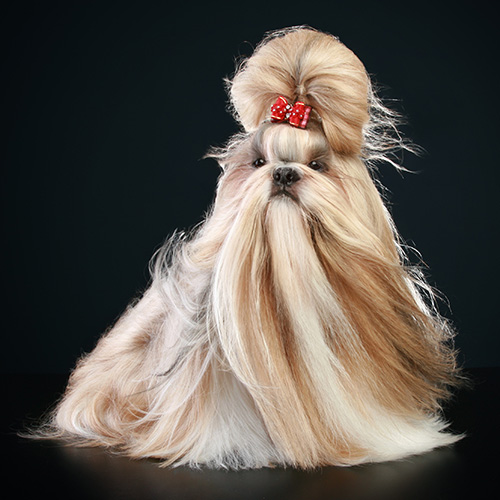 This article on Shih Tzus is part of a series to highlight the Big Picture of health, welfare and breeding and to help develop Globally Relevant Integrated Health Profiles (GRIHPs) for many breeds. See IPFD's Get a GRIHP! on Breed Health Initiative.
This article on Shih Tzus is part of a series to highlight the Big Picture of health, welfare and breeding and to help develop Globally Relevant Integrated Health Profiles (GRIHPs) for many breeds. See IPFD's Get a GRIHP! on Breed Health Initiative.
 Donate
Donate
 Brachycephalic and chondrodysplastic conformation causes the most important health risks in the breed.
Brachycephalic and chondrodysplastic conformation causes the most important health risks in the breed.


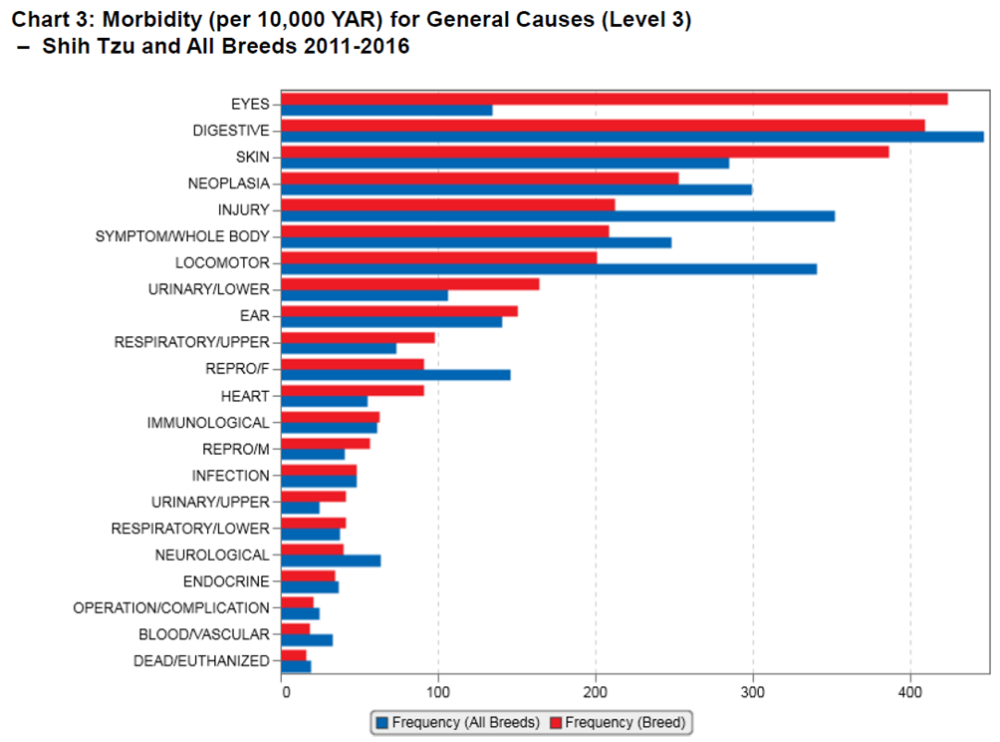



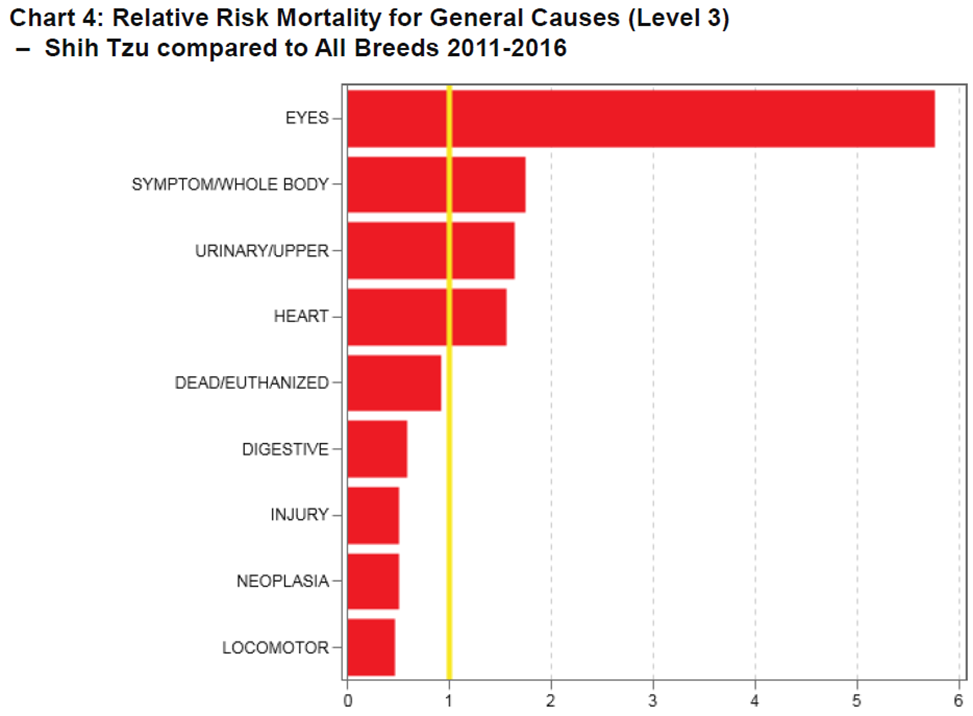
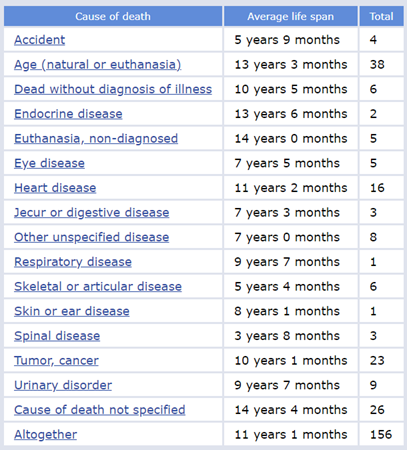
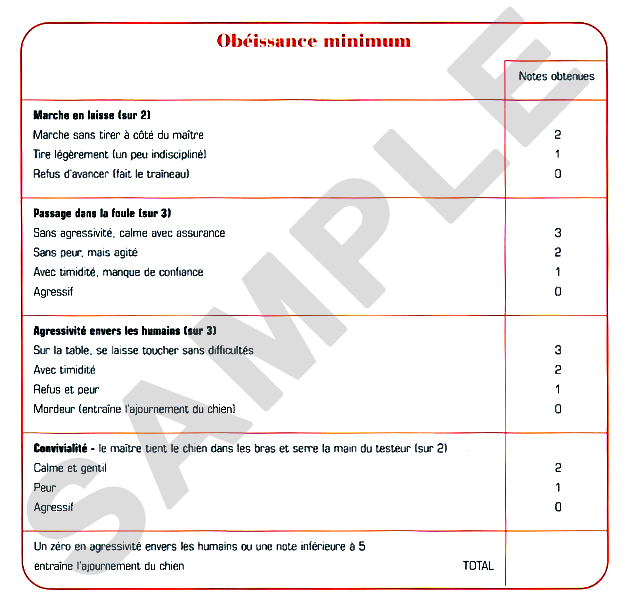

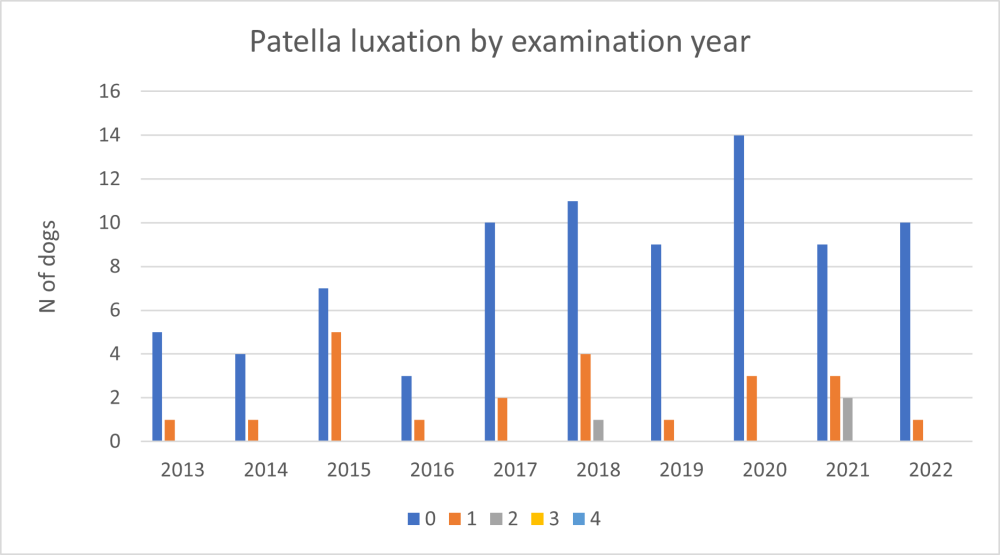
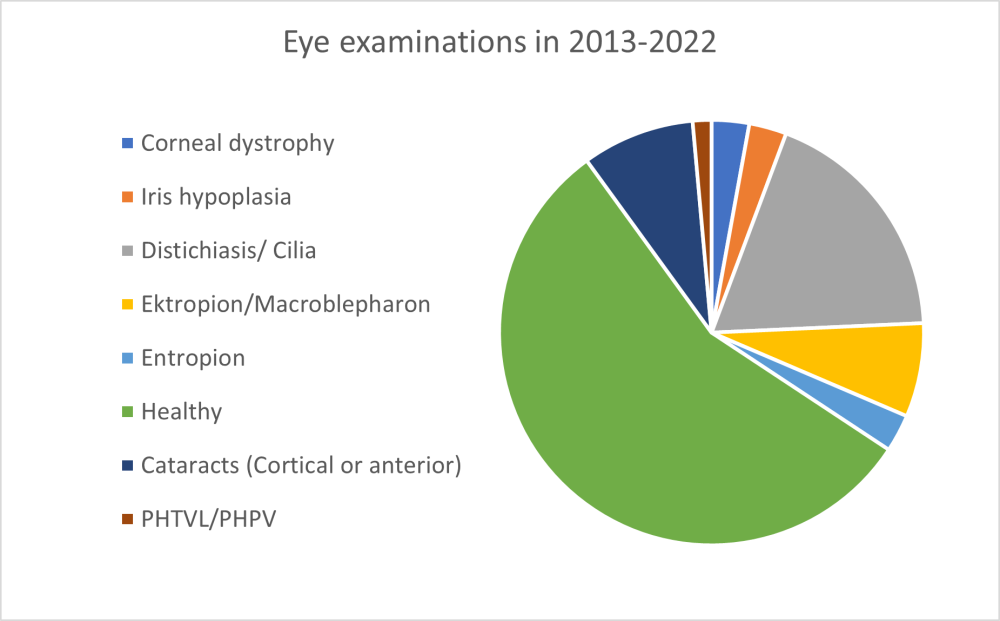
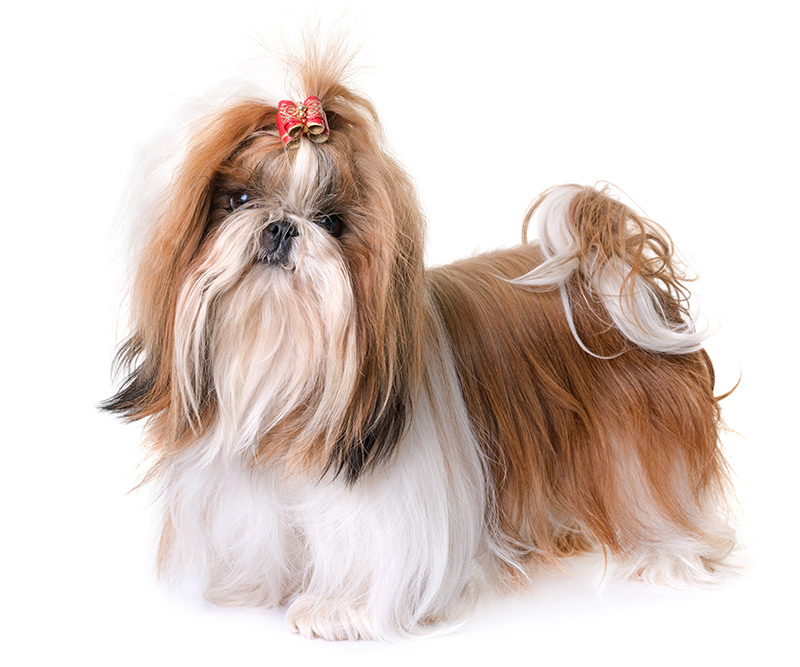

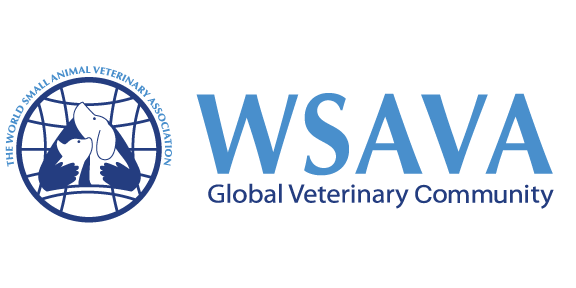
Recommended Comments
There are no comments to display.
Join the conversation
You can post now and register later. If you have an account, sign in now to post with your account.
Note: Your post will require moderator approval before it will be visible.